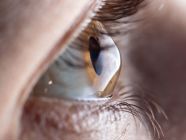Almost 1 in 4 diabetics suffers from diabetic retinopathy, which occurs as a result of high blood sugar levels over many years, which leads to gradual damage to the small blood vessels in the eye, causes changes in vision, and in severe or untreated cases may lead to vision loss. (1) (2)
The probability of developing diabetic retinopathy increases the longer the period of diabetes and the less control the patient has over his blood sugar level. It is worth noting that retinopathy occurs without symptoms in the early stages, so it is important for diabetics to examine the retina annually. (3)
Symptoms of diabetic retinopathy
No symptoms appear in the early stages of the disease. As the disease progresses, the following symptoms may appear: (4)
- Blurred vision: The patient may see blurry or dark spots in the field of vision.
- Eye floaters (myodesopsias): The patient may see black dots or strings floating in the field of vision.
- Loss of night vision (Nyctalopia): The patient may have difficulty seeing at night.
- Central Vision Loss: In severe cases, the patient may lose vision in the center of the visual field.
Causes of diabetic retinopathy
High blood sugar levels for long periods as a result of diabetes are considered the main cause of diabetic retinopathy, as hyperglycemia led to blockage or bleeding of the blood vessels that feed the retina. Over time, the body begins to replace these damaged blood vessels with new ones, but they are fragile and abnormal. (5)
There are Factors that increase the risk of developing diabetic retinopathy, the most important ones are: (3)
- Having diabetes for a long time.
- Lack of good control of blood sugar readings.
- Hypertension.
- Hypercholesterolemia .
- Pregnancy.
- Smoking. (7)
Stages of diabetic retinopathy
Diabetic retinopathy is divided into two stages: (3) (4)
- Early diabetic retinopathy
It is the most common type, in which the walls of the blood vessels in the retina weaken, and small bumps or bulges form on them, causing blood and fluids to leak from the blood vessels into the retina, and causing swelling and puffiness of the retinal macula.
- Late-onset diabetic retinopathy
It is the most advanced and severe stage of diabetic retinopathy. At this stage, fragile and abnormal blood vessels form in the retina and the vitreous (the gelatinous fluid that fills the back of the eye). These new blood vessels may leak their contents, including blood and fluids, into the vitreous, causing symptoms such as blurred vision. In addition, the retina may become detached from its normal location and scarring may occur, which increases pressure on the eye and ultimately leads to damage to the optic nerve and glaucoma.
Detection of diabetic retinopathy
If you have diabetes, it is necessary to undergo annual eye examinations. These examinations are simple and painless. The doctor will give you eye drops to dilate the pupil and then examine the eye and retina comprehensively. (6)
If the doctor finds that you have retinopathy, he may request a color photography of the retina to see the blood vessels in the retina and determine the extent of the damage. (6)
Treatment of diabetic retinopathy
Treatment of diabetic retinopathy depends on several factors, the most important of which are: general health, age, associated symptoms, and severity of the injury. Treatment methods include: (4) (6)
Monitor eyes and control sugar levels
In the early stages of the disease, doctors only monitor the affected eye by conducting a comprehensive examination every 2-4 months, in addition to emphasizing the importance of controlling blood sugar levels by following a healthy diet, exercising, and adhering to the doctor’s instructions regarding medications and other treatments.
Eye injection
These injections help reduce retinal swelling and maintain the health of the blood vessels in the eye, which reduces the damage caused by diabetic retinopathy, the most important of which are: anti-vascular endothelial growth factor (Anti-VEGF) injections. The doctor determines the number of injections that the patient needs according to his condition.
Laser treatment
This is to help close damaged, leaking blood vessels, or reduce the size of the blood vessels and prevent them from growing again, which reduces retinal swelling and resulting damage. Sometimes the patient needs more than one session to obtain satisfactory results.
Surgical treatment
In some severe cases, retinal surgery may be needed.
Sight is a priceless blessing, so why wait? Take your step now and consult one of our specialist doctors Ophthalmology department At Al-Ahli Hospital to examine your eyes in a timely manner.
References
- Diabetic Retinopathy - StatPearls - NCBI Bookshelf
- Diabetic retinopathy - symptoms, treatments and causes | healthdirect
- Diabetic retinopathy | AOA
- Diabetic Retinopathy: Causes, Symptoms, Treatment - American Academy of Ophthalmology
- Diabetic retinopathy | Diabetes and eye problems
- Diabetic Retinopathy | National Eye Institute
- The association of smoking and risk of diabetic retinopathy in patients with type 1 and type 2 diabetes: a meta-analysis






